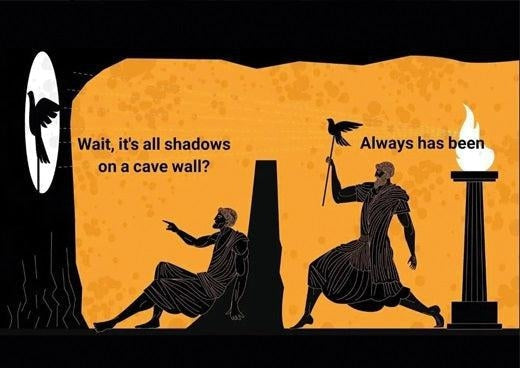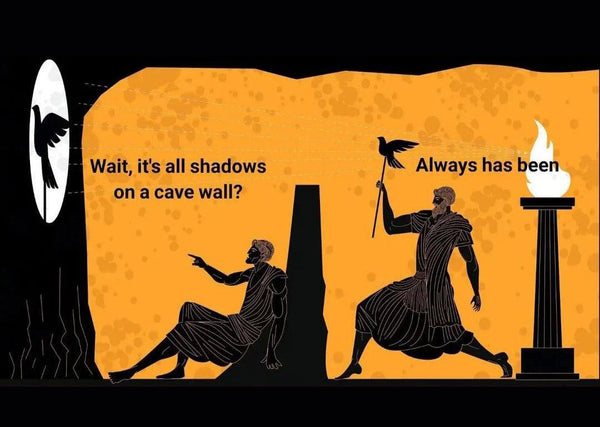

· By Markus Uehleke
Plato's Allegory of the Cave: Unveiling the Truth Behind the Shadows

Imagine a group of people living their entire lives inside a dimly-lit cave, bound by chains so tight they can't even turn their heads. They can only see the wall in front of them, where puppeteers create shadows that they mistake for reality. Sounds strange, right? Well, buckle up, because we're about to dive into Plato's Allegory of the Cave - a mind-bending concept that may have you questioning everything you thought you knew in the most hilarious way possible.
Picture your favorite Netflix binge-watching session. You're comfortably nestled on your couch, munching on popcorn, and fully immersed in a world of fictional wonders. Now, imagine being forever stuck in that living room, missing out on the ocean's salty breeze, the warmth of sunlight, and even the occasional sunburn (ouch). This is the reality for the cave dwellers in Plato's allegory - oblivious to the vast universe beyond their shadowy prison.
In Plato's cave, the puppeteers are the ones pulling the strings, creating the shadows that the prisoners mistake for reality. But let's not forget about the puppeteers' role in all this - they're like the directors of a supernatural reality show, manipulating perceptions and keeping the cave dwellers blissfully ignorant. So, next time you're binge-watching reality TV, be grateful that you're not part of Plato's cave crew.
You might have come across references to Plato's Allegory of the Cave in movies like "The Matrix" or "Inception." However, it's important to note that they often misinterpret the true essence of Plato's theory. Pop culture tends to focus on the idea of constant deception, where people live in a world of illusion. But hold the phone! Plato's point is not about constant deception, but rather the journey from ignorance to enlightenment. Deep, huh?
Plato's Allegory of the Cave goes beyond a simple reality check; it delves into the realm of metaphysical philosophy. He believed that the world we perceive is just an imperfect, fleeting reflection of an ideal, unchanging reality. These ideal forms, as Plato called them, are like the ultimate versions of everything we see in the cave - the perfect chair, the perfect tree, the perfect pizza (yes, even pizza!). They exist in a higher and truer realm, untouched by the flaws of the physical world.
In the Allegory of the Cave, Plato emphasizes the journey from darkness to light, from the world of mere appearances to the realm of ideas. He suggests that by freeing ourselves from the chains of ignorance, we can ascend beyond the cave and experience the true forms. It's like upgrading from a grainy 1990s TV to a dazzling 4K Ultra HD projector - seeing the world in its most perfect and authentic state.
Plato believed that the realm of ideas, also known as the world of forms or intelligible realm, is a place of perfection and eternity. In this realm, the ideal forms of everything we perceive in the physical world exist. These ideal forms are universal and unchanging, representing the true essence of their respective objects. For example, in the realm of forms, there is the perfect idea of a cat, which encompasses all the essential qualities of what we understand to be a cat - its catness, or cat essence, if you will.
Furthermore Plato argued that our perceptible world is just a flawed reflection or imitation of these ideal forms. The objects we see and experience are imperfect variations of the true forms. We only catch glimpses of the ideal forms through our senses, but true knowledge and understanding come from grasping the concepts in the realm of ideas. It's like comparing a Picasso painting to a photograph - the photograph may capture the appearance, but the painting evokes the artistry and essence.
Plato's Allegory of the Cave takes us on a wild and eye-opening journey, from the darkness of the cave to the blinding light of truth. It invites us to question our perceptions, challenge our realities, and embrace the pursuit of knowledge. So, the next time life throws you a curveball, remember Plato's cave dwellers and their awe-inspiring quest for enlightenment. And don't forget, the truth might just be hiding in the most unexpected places, even in the hilarious pages of a blog post like this one. However, it is worth the time to read the passage of the famous Allegory of the Cave in the original work. You can read it in the seventh book of the work "Politeia" which you can also find it online.
So, you've just finished reading the funniest and most enlightening blog article ever written (we simply like exaggerations). Your mind is blown, your sides ache from laughing, and you would like to enjoy this experience regularly. Here's the kicker: you can simply subscribe to our free memesletter to get just such memes and their explanation delivered to your inbox on a weekly basis. Simply sign up at the bottom of this page!
Additionally you realize that you absolutely need some merch to commemorate this momentous occasion. Well, lucky for you, we've got the perfect selection of witty t-shirts, hilarious mugs, and sassy stickers that will forever remind you of that time you read that incredible blog post. And here's the cherry on top - use the promo code "BLOGREADER" at checkout to get a whopping 15% off your entire order! It's like getting a discount on instant joy and everlasting awesomeness. So go ahead and snag some swag, my friend. You deserve it.
Share:
2 comments
-
this is good learning site
pacifique on
-
Looking forward to many more of these! :)
Launora Sali on










